 This evergreen shrub or small tree is native to Argentina, Paraguay, and Brazil but was introduced into Florida by the mid 1800s as an ornamental and has spread and is considered invasive in Florida, Texas, Southern California, Hawaii, and Puerto Rico. Plants can become established in both disturbed and undisturbed sites but do so more readily in the former. They invade both aquatic and terrestrial habitats where they produce a dense canopy that shades out native vegetation. Rapid growth and a high germination rate have led to the rapid spread of the plant. Control measures are thwarted by the production of sprouts by the roots of cut trees and the desire of people to grow the plant for its beautiful berries and appearance of the tree. USDA Hardiness Zones 9-10
This evergreen shrub or small tree is native to Argentina, Paraguay, and Brazil but was introduced into Florida by the mid 1800s as an ornamental and has spread and is considered invasive in Florida, Texas, Southern California, Hawaii, and Puerto Rico. Plants can become established in both disturbed and undisturbed sites but do so more readily in the former. They invade both aquatic and terrestrial habitats where they produce a dense canopy that shades out native vegetation. Rapid growth and a high germination rate have led to the rapid spread of the plant. Control measures are thwarted by the production of sprouts by the roots of cut trees and the desire of people to grow the plant for its beautiful berries and appearance of the tree. USDA Hardiness Zones 9-10
The following native plants are recommended as alternatives:
Grounsel Tree (Baccharis halimifolia)
This fall blooming semi-evergreen shrub grows up to 12’ tall and is native to roadsides, wastelands, wetlands, brackish shores of marshes and estuaries, and inland shores of coastal barrier islands, from Massachusetts south to Florida and west to Texas and Oklahoma. It has large plumes of flowers followed by clusters of silky white seeds borne by female plants. Flowers provide nectar for butterflies including monarchs and plants are useful for hedges but can become invasive. USDA Hardiness Zones 5-9
Coral Bean (Erythrina herbacea)
A native of low woods, savannas, and swamp and pond margins from North Carolina south to Florida and west to Texas, this deciduous multi-stemmed shrub or small tree grows five to ten feet tall. It has compound leaves with three broad, long, leaflets with pinched tips, and produces plumes of bright scarlet three inch long flowers beginning in mid- to late summer. USDA Hardiness Zones 7-10
Toyon (Heteromeles arbutifolia)
Also called Christmass berry, this evergreen shrub or small tree grows 7-35’ tall and 10-25’ wide. It has leathery leaves edged with sharp teeth, terminal clusters of small lacey white flowers in early summer, and bright orange red fruit that persists into winter. Native to chaparral and rocky canyon slopes from California to Baja. USDA Hardiness Zones 8-10
Santa Cruz Island Ironwood (Lyonothamnus floribundus subsp. aspleniifolius)
This evergreen tree native to rocky slopes, canyons, oak woodland, and chaparral of Southern California usually grows about 30’ tall and has fibrous shredding gray bark with dark cinnamon red new bark beneath. Its palmately compound leaves are 4-6 inches long and have linear leaflets with scalloped margins. From late spring to summer clusters of white flowers are produced in 4-8 inch flattened terminal clusters. USDA Hardiness Zones 9-10
Wild Coffee (Psychotria nervosa)
This evergreen shrub grows up to 15’ tall and is native to marl ridges and hummocks throughout peninsular Florida. It has brilliant red berries and six inch long quilted leaves that are dark green and glossy. USDA Hardiness Zones 8-10
Wafer Ash aka Hop Tree (Ptelea trifoliate)
With small fragrant flowers and yellow foliage in fall, this small deciduous tree can also be grown as a shrub. It is native to wetlands from Ontario to Minnesota, south to Florida and northern Mexico. USDA Hardiness Zones 3-9
Winged Sumac (Rhus copallina)
Winged sumac is a deciduous shrubs producing dense clusters of red seed pods and red foliage in the fall. It grows to 12’ tall and is native to forest edges, fields, meadows, and roadsides from Maine to Wisconsin, south to Florida and Texas. USDA Hardiness Zones 4-8
Smooth Sumac (Rhus glabra)
Smooth sumac is a deciduous shrubs producing dense clusters of red seed pods and red foliage in the fall. It grows to 15’ and is native to prairies, fields, abandon farmland, and clearings of Ontario west to Manitoba, south to Georgia and Texas. USDA Hardiness Zones 3-9.
Paradise Tree (Simarouba amara)
An evergreen tree with pendent panicles of small yellow flowers, it is native to south Florida where it grows in forested hammocks. USDA Hardiness Zones 9-10
California Laurel (Umbellularia californica)
Also called bay laurel, this fragrant evergreen shrub or small tree grows slowly to over 40 feet but can be kept at six to eight feet tall. It is native to the mountains of California and into Oregon where it grows in chaparral, mixed-evergreen forests, redwood forest, yellow pine forests, and central oak woodland. USDA Hardiness Zones 7-10
Wild Lime (Zanthoxylum fagare)
Although not a true lime, this evergreen spreading shrub or small tree is aromatic with a hint of citrus. It has spines and is an important species for wildlife including hosting the larvae of two swallowtail butterflies. Native to southern Florida and Texas, Mexico, Central America, the Caribbean, and South America to Paraguay. USDA Hardiness Zones 9-11
Photo Credit: Tarciso Leao, Wikimedia